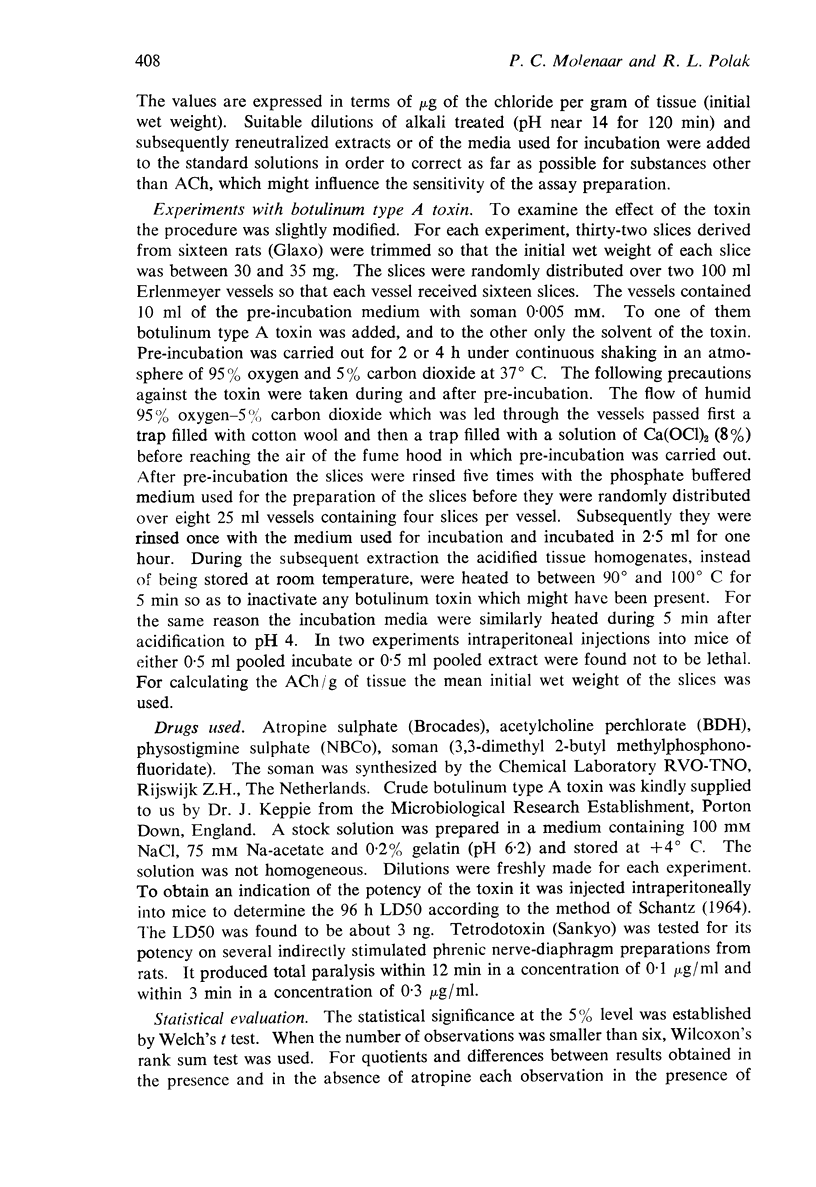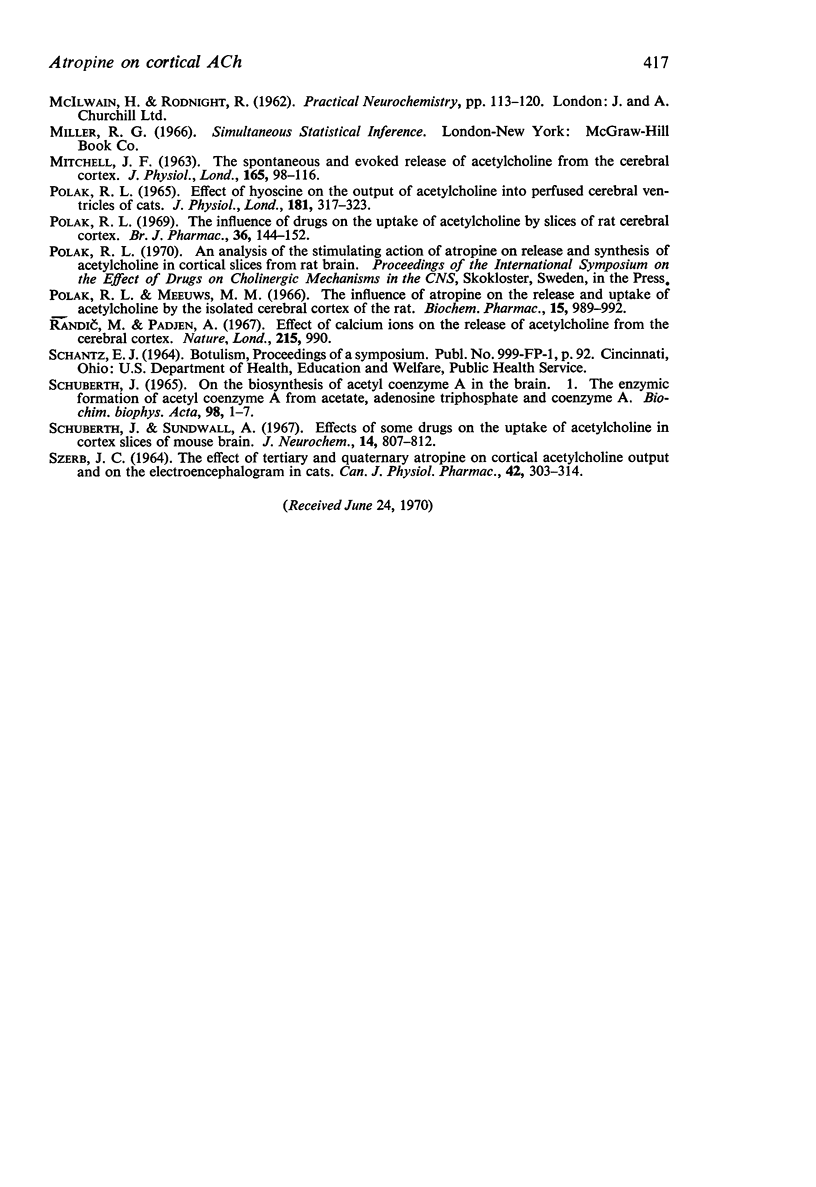Abstract
1. Cortical slices from rat brain were incubated in media containing the irreversible cholinesterase inhibitor soman and a high KCl concentration, and the release and synthesis of acetylcholine (ACh) were determined.
2. Atropine enhanced the release and synthesis of ACh.
3. Tetrodotoxin, a substance which blocks nervous conduction, did not influence the release and synthesis of ACh, in the absence or in the presence of atropine. Therefore the nerve endings are probably the site at which atropine acts when stimulating the release and synthesis of ACh.
4. Pretreatment of the slices with botulinum type A toxin partially blocked the release and synthesis of ACh and reduced the extra amounts of ACh released and synthesized under the influence of atropine.
5. Lowering the calcium or raising the magnesium concentration in the incubation medium reduced the release and synthesis of ACh and their enhancement by atropine.
6. Physostigmine decreased the total extractable ACh content of the slices during incubation in a 25 mM KCl containing medium. This decrease was nearly prevented when the release and synthesis of ACh were inhibited by omission of the calcium ions from the medium, but was enhanced by atropine.
7. The observations made with pretreatment by botulinum type A toxin, with changes in the calcium and magnesium concentration as well as with physostigmine, all support the theory that it is primarily the release of ACh which is enhanced by atropine and that its stimulating action on the synthesis results from the increased release.
Full text
PDF











Selected References
These references are in PubMed. This may not be the complete list of references from this article.
- BROOKS V. B. An intracellular study of the action of repetitive nerve volleys and of botulinum toxin on miniature end-plate potentials. J Physiol. 1956 Nov 28;134(2):264–277. doi: 10.1113/jphysiol.1956.sp005642. [DOI] [PMC free article] [PubMed] [Google Scholar]
- Bertels-Meeuws M. M., Polak R. L. Influence of antimuscarinic substances on in vitro synthesis of acetylcholine by rat cerebral cortex. Br J Pharmacol Chemother. 1968 Jun;33(2):368–380. doi: 10.1111/j.1476-5381.1968.tb00997.x. [DOI] [PMC free article] [PubMed] [Google Scholar]
- DEL CASTILLO J., KATZ B. Changes in end-plate activity produced by presynaptic polarization. J Physiol. 1954 Jun 28;124(3):586–604. doi: 10.1113/jphysiol.1954.sp005131. [DOI] [PMC free article] [PubMed] [Google Scholar]
- Dudar J. D., Szerb J. C. The effect of topically applied atropine on resting and evoked cortical acetylcholine release. J Physiol. 1969 Aug;203(3):741–762. doi: 10.1113/jphysiol.1969.sp008890. [DOI] [PMC free article] [PubMed] [Google Scholar]
- ELLIOTT K. A. C., SWANK R. L., HENDERSON N. Effects of anesthetics and convulsants on acetylcholine content of brain. Am J Physiol. 1950 Aug 1;162(2):469–474. doi: 10.1152/ajplegacy.1950.162.2.469. [DOI] [PubMed] [Google Scholar]
- Elmqvist D., Feldman D. S. Spontaneous activity at a mammalian neuromuscular junction in tetrodotoxin. Acta Physiol Scand. 1965 Aug;64(4):475–476. doi: 10.1111/j.1748-1716.1965.tb04206.x. [DOI] [PubMed] [Google Scholar]
- GIARMAN N. J., PEPEU G. THE INFLUENCE OF CENTRALLY ACTING CHOLINOLYTIC DRUGS ON BRAIN ACETYLCHOLINE LEVELS. Br J Pharmacol Chemother. 1964 Aug;23:123–130. doi: 10.1111/j.1476-5381.1964.tb01573.x. [DOI] [PMC free article] [PubMed] [Google Scholar]
- Gage P. W., Quastel D. M. Competition between sodium and calcium ions in transmitter release at mammalian neuromuscular junctions. J Physiol. 1966 Jul;185(1):95–123. doi: 10.1113/jphysiol.1966.sp007974. [DOI] [PMC free article] [PubMed] [Google Scholar]
- HUBBARD J. I. The effect of calcium and magnesium on the spontaneous release of transmitter from mammalian motor nerve endings. J Physiol. 1961 Dec;159:507–517. doi: 10.1113/jphysiol.1961.sp006824. [DOI] [PMC free article] [PubMed] [Google Scholar]
- Hemsworth B. A., Mitchell J. F. The characteristics of acetylcholine release mechanisms in the auditory cortex. Br J Pharmacol. 1969 May;36(1):161–170. doi: 10.1111/j.1476-5381.1969.tb08313.x. [DOI] [PMC free article] [PubMed] [Google Scholar]
- Kao C. Y. Tetrodotoxin, saxitoxin and their significance in the study of excitation phenomena. Pharmacol Rev. 1966 Jun;18(2):997–1049. [PubMed] [Google Scholar]
- Katz B., Miledi R. Tetrodotoxin and neuromuscular transmission. Proc R Soc Lond B Biol Sci. 1967 Jan 31;167(1006):8–22. doi: 10.1098/rspb.1967.0010. [DOI] [PubMed] [Google Scholar]
- LILEY A. W. The effects of presynaptic polarization on the spontaneous activity at the mammalian neuromuscular junction. J Physiol. 1956 Nov 28;134(2):427–443. doi: 10.1113/jphysiol.1956.sp005655. [DOI] [PMC free article] [PubMed] [Google Scholar]
- Liang C. C., Quastel J. H. Uptake of acetylcholine in rat brain cortex slices. Biochem Pharmacol. 1969 May;18(5):1169–1185. doi: 10.1016/0006-2952(69)90120-8. [DOI] [PubMed] [Google Scholar]
- MACINTOSH F. C. SYNTHESIS AND STORAGE OF ACETYLCHOLINE IN NERVOUS TISSUE. Can J Biochem Physiol. 1963 Dec;41:2555–2571. [PubMed] [Google Scholar]
- Mann P. J., Tennenbaum M., Quastel J. H. Acetylcholine metabolism in the central nervous system: The effects of potassium and other cations on acetylcholine liberation. Biochem J. 1939 May;33(5):822–835. doi: 10.1042/bj0330822. [DOI] [PMC free article] [PubMed] [Google Scholar]
- Mitchell J. F. The spontaneous and evoked release of acetylcholine from the cerebral cortex. J Physiol. 1963 Jan;165(1):98–116. doi: 10.1113/jphysiol.1963.sp007045. [DOI] [PMC free article] [PubMed] [Google Scholar]
- Polak R. L. Effect of hyoscine on the output of acetylcholine into perfused cerebral ventricles of cats. J Physiol. 1965 Nov;181(2):317–323. doi: 10.1113/jphysiol.1965.sp007763. [DOI] [PMC free article] [PubMed] [Google Scholar]
- Polak R. L., Meeuws M. M. The influence of atropine on the release and uptake of acetylcholine by the isolated cerebral cortex of the rat. Biochem Pharmacol. 1966 Jul;15(7):989–992. doi: 10.1016/0006-2952(66)90176-6. [DOI] [PubMed] [Google Scholar]
- Polak R. L. The influence of drugs on the uptake of acetylcholine by slices of rat cerebral cortex. Br J Pharmacol. 1969 May;36(1):144–152. doi: 10.1111/j.1476-5381.1969.tb08311.x. [DOI] [PMC free article] [PubMed] [Google Scholar]
- Randic M., Padjen A. Effect of calcium ions on the release of acetylcholine from the cerebral cortex. Nature. 1967 Aug 26;215(5104):990–990. doi: 10.1038/215990a0. [DOI] [PubMed] [Google Scholar]
- SCHUBERTH J. ON THE BIOSYNTHESIS OF ACETYL COENZYME A IN THE BRAIN. I. THE ENZYMIC FORMATION OF ACETYL COENZYME A FROM ACETATE, ADENOSINE TRIPHOSPHATE AND COENZYME A. Biochim Biophys Acta. 1965 Feb 1;98:1–7. doi: 10.1016/0005-2760(65)90002-0. [DOI] [PubMed] [Google Scholar]
- SZERB J. THE EFFECT OF TERTIARY AND QUATERNARY ATROPINE ON CORTICAL ACETYLCHOLINE OUTPUT AND ON THE ELECTROENCEPHALOGRAM IN CATS. Can J Physiol Pharmacol. 1964 May;42:303–314. doi: 10.1139/y64-036. [DOI] [PubMed] [Google Scholar]


